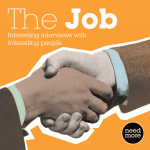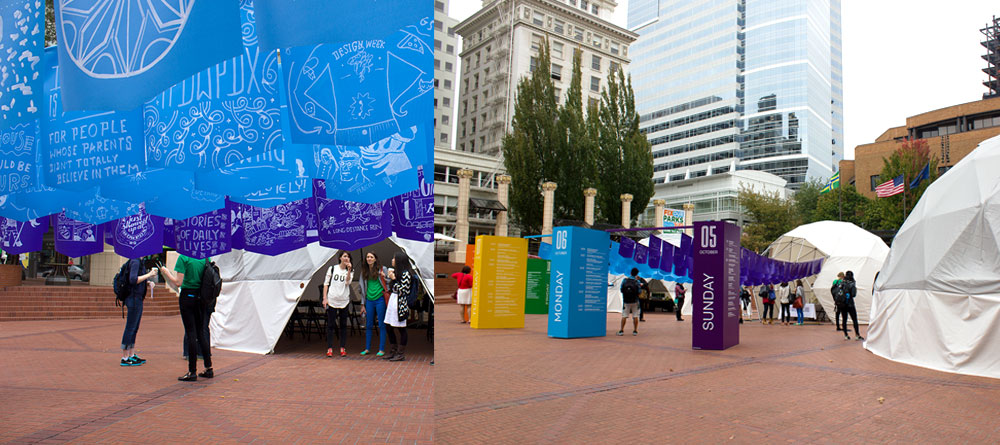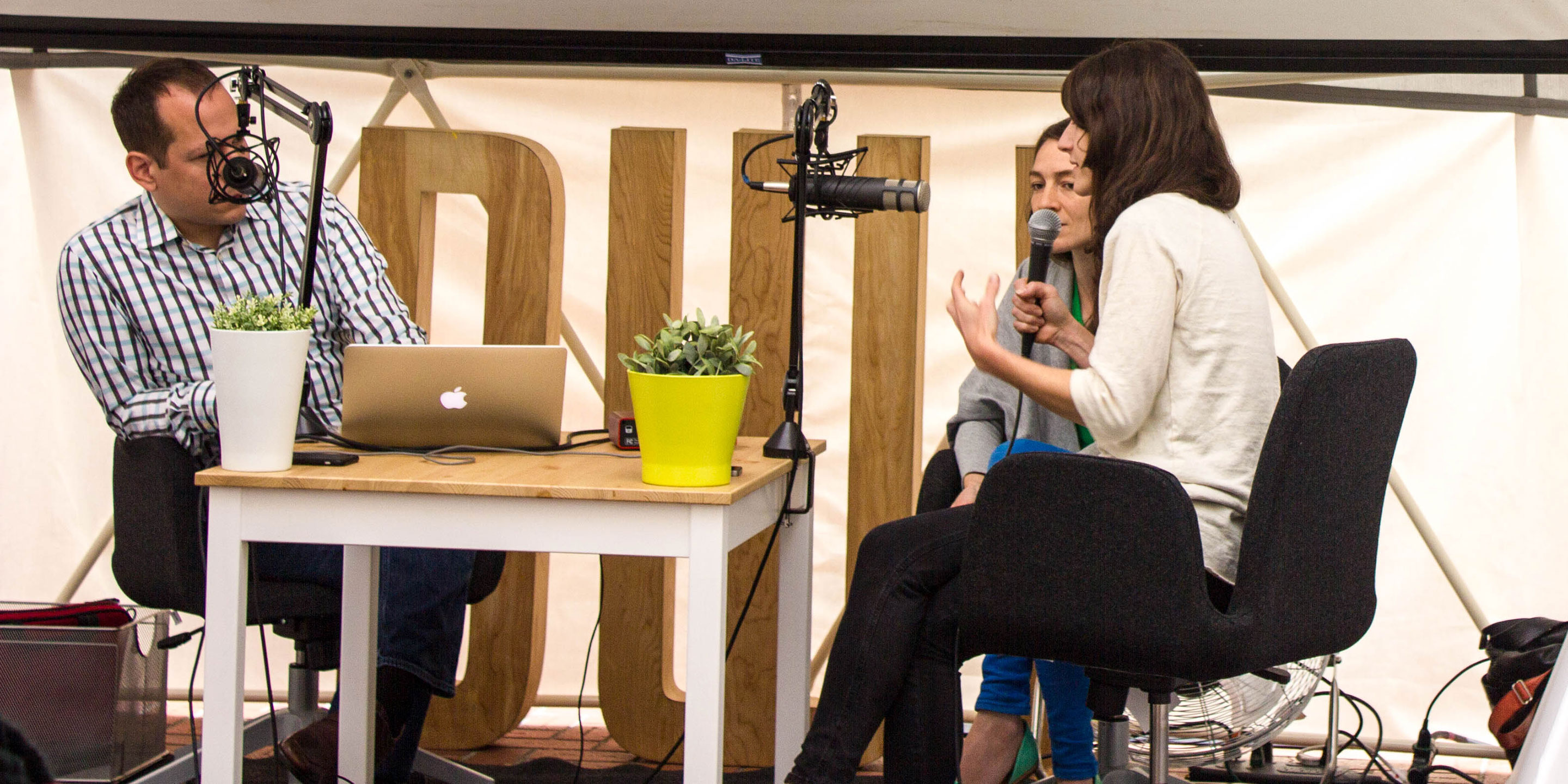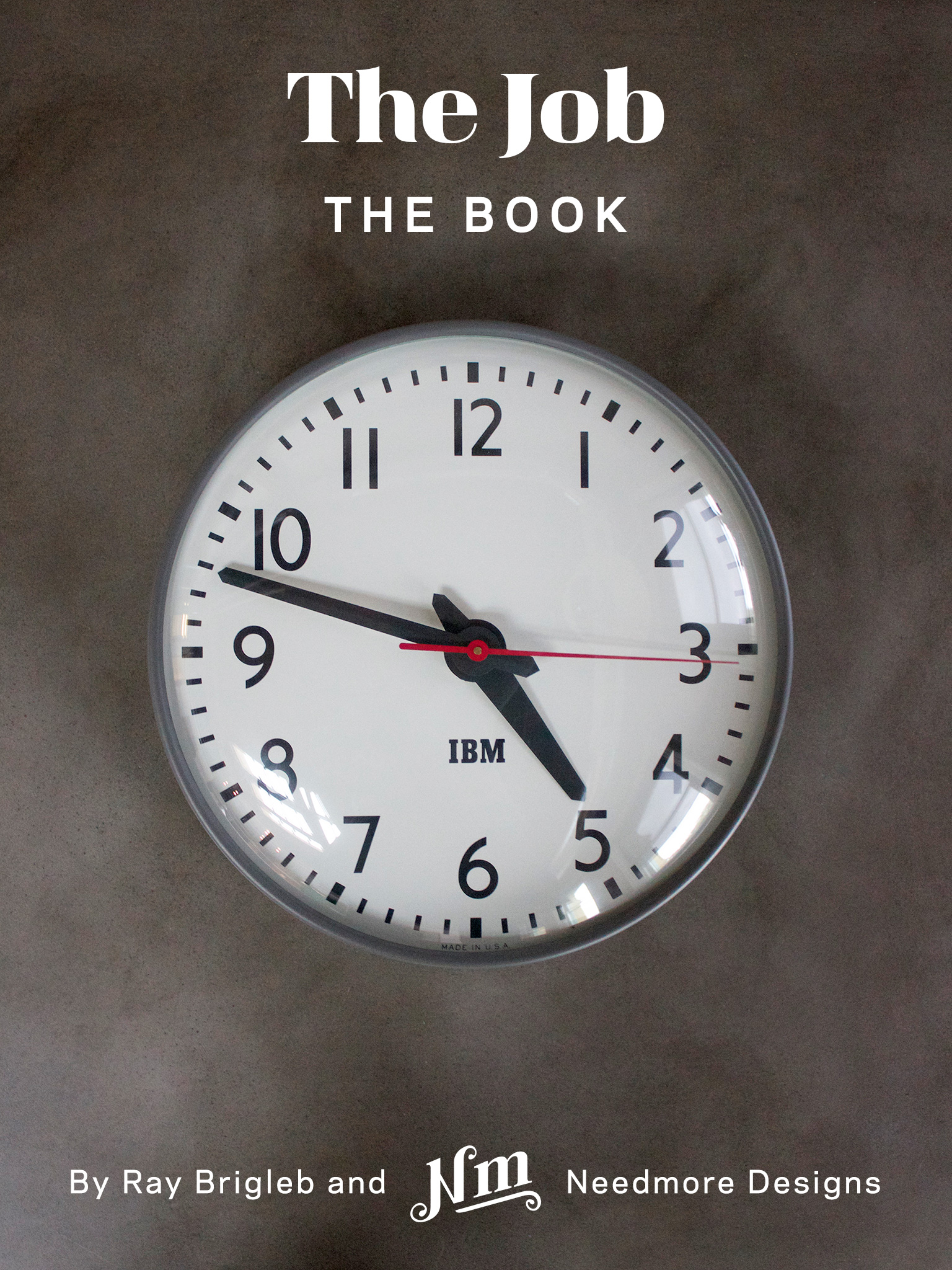
Kelsey Snook and Melissa Mongiat of Daily Tous Les Jours are environmental interactive designers based out of Montréal.
The Interview
- Ray:
- I have 2 guests with me today and why don’t you introduce yourselves.
- Melissa:
- Hi, I am Melissa I am Co-founder of this design studio Daily Tous Les Jours.
- Kelsey:
- I’m Kelsey Snook and I am Senior Creative Partner.
- Melissa: Yay.
- So, we’re going to talk a little bit. Why don’t we start the beginning and maybe let’s hear the story of how this agency came about?
- Kelsey: How we met and fell in love? Because it starts with that. Well, 10 years ago, Melissa and I met in London at Central St. Martins, there was a masters course called creative practice for narrative environments and we came from different backgrounds, it’s a multidisciplinary practice. So Melissa came from a kind of a graphics background and I came from kind of an industrial design background-
- Melissa: It’s always kind of.
- Kelsey: Yeah, kind of. We had this shared interest in creating spaces and experiences that can communicate stories. Then the other interest that we ended up turning into a thesis project together is how you get people to participate and engage in those spaces. Like, what’s that magic mix that gets people, draws people in to participate and do something.
- Melissa: The studio itself actually was born when I got back to Montreal after London. Kelsey went to Portland and I went back home in the name of love to Montreal and I met another girl who also she was in New York, not in London, who came back home in the name of love and it was Mouna Andraos and we met and we clicked and we decided to start a studio together. That didn’t have any name at the beginning, we really started with just projects and slowly we had a team and slowly we had a space and then we found a name and Kelsey was always in the portrait.
- OK. Was the idea something that evolved for what you do? Or was it there from day 1?
- Melissa: What? The idea of?
- Well, I mean, I consider what you do to be sort of creating narrative environments, shared experiences from people. Was that what you started with as a goal?
- Melissa: Yes, definitely. It’s what we studied, Kelsey and I in London and it sticked with us and it’s also what Mouna was doing her own way in New York. So narrative environment is our thing interaction design and participation I would say is also a focus, but in terms of the shape that the projects take, it takes us into whole different sets of journeys.
- OK. It seems like a lot of what you do kind of involves technology as an enabler, for the types of projects you do. Maybe you could tell us about one that’s an example and how that may have been a challenge or how you work around the technology to do what you set out to do in a project?
- Kelsey: Every project starts with identifying a purpose, what do we want people to do, what’s the just, kind of core experience?
Technology is really just, we consider it as part of the tools that we have to make a project. It is taking more and more place in our lives so it is taking more and more place at the table of solutions when we identify the purpose and start tackling a project. Tons of examples.
- Kelsey: Yeah. If you think of an example, I will say one thing about just how we treat technology. We kind of just first identify what we think is the level of engagement or kind of interaction that we want people to have. Not necessarily the interaction design or technology that we have to use initially. So first when thinking about kind of what’s that story that we want people to experience or what’s that kind of purpose meaning for people to interact? Then we think about what technology, low or high tech and for example just outside here is a really low technology. Humans over there are interpreting tweets that are happening and it’s kind of a beautiful mutation of a dialogue but it’s-
- Melissa: You want to describe it?
- Kelsey: …oh right, so what happens outside is-
- For those of you at home.
- Kelsey: …designers Portland, yeah for those of you at home, is, we are at the domes at headquarters in Pioneer Square and all the tweets that are happening during design week are being designed by designers and hung up on flags, color coded each day in Pioneer Square. So today we are yellow.

Design Week Portland Flags and Domes in Pioneer Courthouse Square
- Melissa: So, I’ve been thinking about an example for you.
- OK, great.
- Melissa: I haven’t been thinking very hard, because the first thing that comes to mind is the swings. Technology is often seamless in our projects or very accessible. In the case of the swings, we did a set of 21 musical swings in Montreal and now we have a kit of 10 swings that are touring around the world. In creating these musical instruments crossed with urban furniture it’s really about this intuitive interface and magically the swings make music, but you’re not necessarily conscious that there’s technology under the seat you’re sitting on. The same way when we, we’ve done a set of interactive projections and often we will choose SMS texting systems versus intelligent phone usage and having to download an app for whatever you need to do just so that it’s really easy, accessible to all.
- So, when talking about experiences like this, obviously people have a lot of shared experiences online, on Facebook and so forth. But that’s not what you guys do, why isn’t Facebook good enough? Why do we need public spaces like Portland’s Living Room here?
- Kelsey: Well, one of the things that just we’ve been talking about the past couple days is just the fact that when you are online, the way that many social media experiences are crafted, they help introduce you to your circles and you’re kind of sphere and people connected to you. That is kind of a model of how people meet and expand their networks, but it’s being curated for us and I guess you could say that we’re curating the experience as well, but there is something, there is this kind of when we talk about these magical things that we love about creating spaces, you, today in Pioneer Square are sitting next to strangers and other strangers who are passing by because there’s transit networks and all these other shops around. So, there’s something about just rubbing elbows with strangers that lets us, it’s kind of like this democratic process.
No, very much so, there’s Michael Sandel that we often quote that has this beautiful saying and this idea of a common life and how it’s important to share a common life by just having a sense that we live together and I think there are more and more people living in cities. It’s undeniable that we need to find ways to better live together, because they will be more crowded as we go on and more issues arise when this happens. So, how can we create a base for communication, so that when problems arise there is something that’s set for things to happen together.
- So kind of serendipity is democratic, on a personal level maybe?
- Kelsey: In how it helps you to gain awareness to others, yeah.
- Mm hmm.
- Kelsey: I would say so.
- Going back to the musical swings, you guys are kind of known for that. How has that set the tone for your business since then or changed the nature of your business or helped you get clients?
- Kelsey: Hmm, clients. We work a lot on arts commissions. We have an interesting model, I think my favorite one is one Steve Dietz says, “So you’re designers, who work mainly on arts commissions.” So the swings were very much so an arts commission, but they got great exposure and we learned a lot because the project has been going on every spring in Montreal. So, in repeating a project, you get to learn with every edition you try to make it better and so I think there was a lot of learning that came from this project through its success and the fact that it’s been shuttling repeatedly. At the same time that we showed the swings, we also had Giant Sing Along that was quite popular and I think it provided us with enough variety so that we’re not only stapled to the swings.
- Right.
- Kelsey: How has that gotten, has that elevated business for us from doing that?
- Melissa: Well definitely people know us from that project, I mean sheer publicity and-
- Last night you alluded to Oprah, did Oprah mention the swings at some point?
- Kelsey: It was one of her favorite things.
- Melissa: She showed it, we were part of her Super Soul Sunday show. It was really nice, we saw our film with Oprah’s voice over. Felt like Santa Claus.
- Another thing that you did in Vancouver, was the video piece that was-
- Melissa: Yes, Rewright the Year?
- Is that the thing that-
- Kelsey: McLarena?
- Yes. Where it was kind of a loop of-
- Kelsey: McLarena, yeah.
- So, that project in particular seemed extremely complicated and technical to pull off, more so than a lot of the other ones.
- Melissa: Really?
- It did, to my eyes. When I was watching that. Did you run into things that you just couldn’t do or was any of it just impossible, that you were trying to accomplish there?
- Melissa: I’m really curious because you saw more of the-
- Behind the scenes maybe, yeah-
- Melissa: …the behind the scenes, so maybe that’s why you have this impression.
- OK.
- Melissa: Actually, McLarena was one of the easiest that we’ve ever done.
- OK, interesting.
- Melissa: Maybe, also the guts are more exposed in this case, like in the swings everything is hidden and you can barely sense the technology. With the McLarena there’s a button you push and there’s an immediate feedback on screens, so maybe you can sense some more-
- Kelsey: The technology.
- Melissa: …of the technology that is part of the project. It wasn’t that simple, but compared to other challenges that we’ve surpassed it was not so bad.
- What was the most challenging thing that you’ve done?
- Kelsey: Swings-
- Melissa: I think the Amateur Intelligence Radio-
- Kelsey: Oh really-
- Melissa: …for some parts. It’s a robot community radio and I think just trying to come up with an artificial intelligence for a building that tells stories according to what’s happening in the building was quite a challenge, but a beautiful idea.
- It sounds challenging, yeah.
- Melissa: The swings also had an interesting challenge because of just the physicality of them and how they were successful meant also how they needed to be robust and we learned a lot not only about technologies, but also engineering and the whole world of-
And the manufacturing, it became into a manufacturing thing. It started off as a one off installation which was fine, it lasted that season. But then to make it, you kind of had to go into manufacturing mode to make it industrially designed to withstand repeat use every single year and that’s a whole different way of thinking.
- Yeah, the fact that people use these things so much seems to introduce a new dynamic that maybe complicates the process. As you say having to learn manufacturing to make it. I noticed that you’ve done a lot of things in the twin cities, what’s the connection there? Is there a particular connection to the twin cities that you guys have?
- Melissa: Well, we know Steve Dietz from Northern Lights, he found us and at the beginning it was a competition and Giant Sing Along came about through that competition and it was a really wonderful project with Steve, it was with the Minnesota state fair, and with the state fair and through that came other projects and also-

From left to right, The Swings in Montréal (21 Balançoires), Amateur Intelligence Radio, and the Giant Sing along at the Minnesota State Fair. Photo Credit: Daily Tous Les Jours
- Kelsey: But then a totally different connection was through the Portland Art Museum.
- Melissa: Yeah.
- OK.
- Kelsey: We met Sarah Schultz, the curator of public practice at the Walker Art Center so there’s kind of like 2 different relationships that happened to reside in that area.
- OK.
- Melissa: I don’t know if you were hoping for more to see. We can make up something. That’s more exciting, if you want.
- No, it’s great. That’s perfect. I’ve looked on your website and you have a very diverse team which makes perfect sense considering the diverse projects that you do. Do you find yourself having to hunt down people to help out on particular projects or how do you find people who are interested in this kind of a thing?
- Melissa: I think every project dictates the kind of team that will be required and when we approach external collaborators it’s often for what they’re good at it so it speaks to them. For all the rest, internally we all share the same schizophrenia in terms of multidisciplinary approach. We all have done something and now do something else and are interesting probably into something else for the future.
- Kelsey: Yeah, there’s this thing, I think we’re always, we probably have a “spidey sense” for who has that same shared genuine interest in human interactions and storytelling. Who gets it, who really gets what you mean when you say engagement and who gets what you mean when you say storytelling. And just kind of practices that-
- Melissa: In the context of narrative environments we need to be careful now when we say storytelling apparently.
- Oh yes, everybody does storytelling yeah.
- Melissa: Watch out.
- Right. Is there a type of a project that you just dream about getting? Like a dream project for you, something super interesting?
- Melissa: Oh, no. That’s an issue we have actually. Do you have a dream project? Because I have this conversation with Mouna over and over and it’s something that we don’t have. We don’t have a dream project. I mean we have many endeavors, we want to work in different types of context, we’re starting to work in Brazil right now and that’s really exciting. That’s always been part of a dream.
- OK. Yeah I was going to ask-
- Melissa: Working in developing countries and trying to see how we can make more of a difference.
- Right, maybe there’s a perfect location-
- Melissa: Exactly, it’s more like seeking the perfect context and then we’ll see where the project comes about. Yeah, do you have a dream project?
- Kelsey: I want to recreate the village fete somewhere. There that and then there’s this project, I just have projects that I’m like, “Ooo, I still want that to happen.” That came from somewhere. There’s that “what’s I ate” project where you get updates from your digestive system, I want that to happen somewhere.
- Melissa: We also have an amazing idea for an escalator. So if you know any really long tall fast escalator, let us know.
- Kelsey: Maybe like in-
- Maybe in the tube or something. I don’t know. OK. Well, I guess I have one sort of big picture question before we wrap, and I don’t know how to ask this properly, but what is it about doing projects that involve people and the public that you like so much? Do you ever just get tired of that? Because a lot of times it seems like you’re dealing with the best in people and then in terms of like maybe things that might happen, like vandalism, you’re dealing with some of the worst and why is it that it’s so much fun for you working with people?
- Kelsey: I think it’s the most rewarding thing because there’s, we always talk about expecting the unexpected and people always surprise you in their ability to be creative with what you offer and to transform the initial idea you had into something sometimes even greater that you couldn’t imagine.
I think it’s also a little bit like in performing arts, it’s the same energy you get from doing a performance or even if it’s others that are performing it’s so thrilling to see people enact or, take part into something that you’ve set up and take it to wherever they want to.
- Kelsey: I can imagine that could be seen as an egotistical thing, like people are doing what we wanted them to do, but-
- Melissa: They are.
- Kelsey: …but it’s more like us being very, very social in a very particular way that we want to. Like somebody would host a dinner party and be so excited that everyone got together and is enjoying food and having that experience together and I think that’s kind of the magic that we get excited about. Is that moment where we see people connecting or doing things they wouldn’t necessarily normally have done by themselves or in a different context. To be able to make that happen or to kind of transport people somewhere else for a moment, that just is exciting and-
- Melissa: Would you like my analogy of a conga line?
- Kelsey: Yeah, sure.
- Melissa: In the end you just start something, but it doesn’t really matter who started it and then it’s just the fun of being all together and doing something.
- Kelsey: In our presentation last night, we were talking about the finite games and infinite games and the infinite game is something that’s played to continue playing and a finite game is a game that has an end to it, an end goal. I think we just like this idea of, and then this book about finite and infinite games, they talk about an infinite game being like a language. In a language you just perpetuate it. It’s a tool that you get to use to continue using for forever.
- Melissa: Then you transform and that enables you to bend the rules-
- Kelsey: And wouldn’t it be exciting to create a language and to have it just breathe and live and enable other people to connect and communicate? I think it comes from that and being able to apply that to real world issues or context to tap in and be relevant to what people are doing. So not just for the fun of it, because it’s a playful lovely thing, but like in the project Rewright the Year, it was 2011 and what a massive year that the world was undergoing and we just had this urge to create something that publicly acknowledged and let people connect over that.
- Melissa: We like the term of infinite city. Working a lot in public spaces, how can we make our cities more malleable to engagement? How can they be more in tune with however we’re evolving right now? When you think of cities they’re always cold, everything is bolted, everything is made not to move. Of course it’s made to last, but I think on one of the big challenge and that was an interesting conversation we had with architects yesterday because they’re also facing the same challenge and building things to last. How do you do build things that last, but that are also made to change? Because everything is changing so fast and you can’t really conceive your environment to be one thing while everything else is going into so many directions.
- Are you two pretty optimistic about cities in general?
- Kelsey: Yes.
- Well played.
- Kelsey: I think in general we’re optimists.

Are they optimists? Melissa answers “Oui!” Photo Credit: Melissa’s Instagram
- OK. Well, thank you guys so much for talking to me. I wonder if it’s OK if we have time for a few questions if you guys are feeling up to it? OK, cool. Does anybody have any questions? OK.
Audience Member: What’s your favorite city?Melissa: Nah, I don’t, do we have a favorite city?Kelsey: I don’t think-You don’t want to piss off all the other cities.Kelsey: I don’t think we have a favorite city, no.Melissa: A city we don’t know yet.Kelsey: I chose Portland and I like it here.Melissa: I do like visiting Portland. I like many cities, it’s a problem.OK, great. Thanks so much you guys.Melissa: Thank you, thank you.

